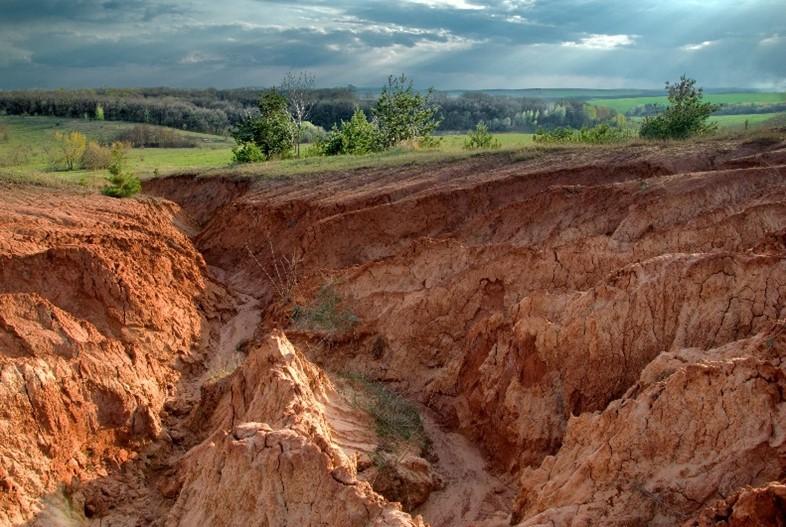
Prevention of Soil Erosion – Factors and Effects of Erosion
Soil Erosion
Introduction:
Soil erosion is a natural process in which physical forces such as wind and water carry away a field’s topsoil.” Soil erosion is a common occurrence in regions of land that are either devoid of vegetation (trees and other plants) or have a small amount of vegetation. As a result of soil erosion, the soil becomes less fertile. The top layer of soil is relatively light; hence wind and water can easily carry it away. The soil particles get loose and washed away in valleys, oceans, rivers, streams, or faraway regions as a result of soil erosion.
Human activities such as agriculture and deforestation have aggravated the issue. Soil erosion is a continuous process that can occur at a slow or rapid pace. It leads to a steady loss of topsoil, ecological degradation, and soil degradation.

Factors Affecting Erosion of Soil
Soil erosion is affected by a range of factors like wind, water, deforestation, cattle overgrazing, and so on.
1. The Wind
The topsoil with the organic stuff gets carried away by the wind when strong winds blow. When the land isn’t covered in grass or vegetation, this happens more frequently. Strong winds blow often in desert and semi-desert locations, where such situations are common.
2. Water
When it rains, the soil in hilly places is swept away to the plains. Running water deposits mineral-rich soil in the riverbed, which can cause the river’s flow to change over time. This can result in flooding, which can result in the loss of life and property. Agricultural potential is lost due to water erosion.
3. Overgrazing by Cattle
When cattle are allowed to graze on the same field over and over again, they eat all of the existing grass, even the roots. As a result, the topsoil is exposed to wind and water, resulting in soil erosion.
4. Forest Deforestation
Humans have taken land from the forest in order to cultivate it in order to feed an ever-increasing population and build houses, industries, and other constructions. Deforestation happens when trees are cut down on a wide scale for these purposes. The roots of trees keep the earth together, preventing it from being uprooted. The topsoil is damaged by wind and running water when significant tracts of forest are cut.

Most Significant Effects of Soil Erosion
The following are some of the most significant effects of soil erosion:
1. Soil Erosion can Degrade the Environment by Turning Lush Green Forests into Deserts:
When the fertile topsoil in a forest is destroyed by soil erosion, the infertile subsoil is left behind. As a result of the remaining barren soil, no forest flora can grow, and the formerly lush green forest may gradually turn into a desert.
Desertification is caused by soil erosion. It turns the habitable zones into deserts. Deforestation and the uncontrolled usage of land worsen the situation. There is also a loss of biodiversity, soil degradation, and ecosystem change as a result of this.
2. Soil Erosion can Cause Famines (Abundant Food Scarcity):
When the fertile topsoil is destroyed by soil erosion, food crops struggle to grow in the infertile soil. As a result of poor crop yields, food grains are in low supply in that region.
3. Soil Erosion can Lead to Flooding:
As rainwater carries soil away from the land, it progressively accumulates on river bottoms (decreasing their depth). As a result, when it rains heavily, the river cannot swiftly remove all of the rainwater. As a result, river water overflows its banks, causing major flooding in the neighboring areas.
Pesticides, insecticides, fertilizers, and other chemicals are observed in agricultural soil. This pollutes the waterways through which the topsoil washes.
Sediments build up in the water, increasing the water level and triggering flooding.
Other Effects of Soil Erosion are:
Dams and their banks can become clogged with soil sediments, limiting their efficiency. As a result, it has an effect on infrastructure projects involving dams, embankments, and drainage.
The dust particles cluster together in the air, causing pollution. Some poisonous substances, such as pesticides and petroleum, are extremely deadly when inhaled. When the winds hit, dust blows from dry and semi-arid areas and produces huge pollution.
Importance of Topsoil
Insects and earthworms are two examples of soil-dwelling creatures. Soil serves as a storehouse for water and nutrients needed by plants to grow. It also provides a home for a wide range of animals that live on or in the soil.
The soil is abundant with air and vitality. Without soil, there would be no grass, no crops, no trees, and no food for humans and other creatures.
Explanation:
Prevention of Soil Erosion
There are various strategies for preventing soil erosion.
Afforestation, crop rotations, terrace farming, shelterbelts, embankments, mulching, matting, and bunding.
Soil conservation is another term for preventing soil erosion. The following methods can be used to reduce soil erosion:
1. Afforestation
Afforestation is the process of adding more trees and plants to an area. If the plants die, all living things will vanish. As a result, if trees are removed, new trees should be planted to replace them. Planting trees in steep areas is the most effective approach to conserving land.

2. Crop Rotations:
The fields remain bare between harvesting one crop and growing the next; there is a period when the farmland is devoid of crops. To prevent soil erosion, the farmer either produces grass or other crops during this time. This aids the soil’s recovery of lost minerals.

3. Terrace Farming
Farming is done on the slopes of the hills in steep locations by cutting steps. This causes the flow of water to slow down, and soil from one step is deposited in the next. As a result, the soil is never completely depleted. This is known as terrace farming.
Soil should be laid horizontally across the line of the slope in terrace farming to prevent soil erosion. Contour farming acts as a reservoir, catching and retaining precipitation, allowing for increased infiltration and more uniform water distribution.

4. Shelter belts
Trees are planted in rows along fence lines to create a shelter belt. They are mostly planted to protect agriculture from cold winds, although they can also provide shade in hot times. In locations like Canterbury, where there are a lot of cultivated lands, shelter belts also serve to reduce wind erosion.
Strong winds are slowed by the plants and trees that surround the area, which protect the soil from being blown away.

5. Embankments:
Placing sturdy structures known as embankments along the river’s banks can protect fields from flooding. These embankments prevent a large amount of rich productive soil from being washed away by overflowing rivers and precipitation.
An embankment is a high earthen wall used to carry a road or railway across low terrain or to keep water from a river or the sea from flooding the region.

6. Applying Mulches:
Appling mulches to soil is the alternative to prevent the erosion of soil.
Mulch on the topsoil allows the soil to absorb water slowly while also protecting it from rain damage and restoring pH levels.
Mulching is done by covering the soil with dead leaves and shredded wood. It serves as a protective covering for the trees and plants against harsh weather conditions.
Mulching helps water to percolate slowly into the soil, reducing the impact of heavy rain or irrigation. Mulches serve to keep the soil from becoming acidic and suppress the growth of weeds. Mulches are comprised of organic materials which decomposed over time, improving soil structure and fertility.

7. Matting:
Matting is coating soil with biodegradable materials such as mulch, straw, coconut fiber, and wood chips. These are held together with biodegradable coco coir netting. It’s like putting a biodegradable carpet over the dirt. The matting material can disintegrate or decay over time and become soil fertilizer.

8. Bunding:
A bund is an erosion-prevention engineering solution that involves placing an obstacle in the path of surface runoff to slow down the flow of water. It helps to control soil erosion by retaining the runoff from the watershed in the watershed. The contour canal can be dug across the flow of water in the same way. In locations with less rainfall and porous soils, contour bunds are constructed.

Coastal Erosion
The loss of coastal lands due to the net removal of sediments or bedrock from the shoreline is known as coastal erosion (or shoreline retreat).
Islands are narrowing and coasts are retreating due to erosion.
Rain and wind transport sand quickly from the hills, causing oceans to rise higher and higher onto the beach.
Coastal erosion can be classified as a rapid-onset danger (happens in a matter of days to weeks) or a slow-onset hazard (occurring over many years or decades to centuries).

Several Approaches for Preventing Coastal Erosion Have Been Utilized in Various Locations
- Groin: In coastal engineering, a groin (sometimes written groin) is a long, narrow structure built out into the sea from a beach to prevent beach erosion or to trap and gather sand that would otherwise float along the beach face and nearshore zone due to waves entering the beach at an angle. A groin can help to stabilize a beach on the updrift side, but erosion on the downdrift side is increased since the groin structure stops drifting sand from replenishing the beach.
- A jetty is a long, thin structure that protects a beach from currents and tides. Wood, earth, stone, or concrete are the most common materials used to construct jetties. They reach out into the water from the coast.
Ocean currents and tides can wash a beach or other things along the shore away over time. This is referred to as erosion. A shoreline can also be eroded by strong river currents or lake waves. Jetties safeguard the body of water’s shoreline by acting as a barrier to erosion caused by currents, tides, and waves.
Jetties can also be used to connect land to deep water further out from the shore for the purpose of docking ships and unloading cargo. Such type of jetty is called a pier.
- Breakwaters: Large piles of rocks are piled parallel to the beach to form a breakwater. Breakwaters are commonly utilized in ports and artificial marinas to calm the water. They serve as a wave barrier, allowing the beach to expand while preventing erosion. When waves crash against the breakwater, they carry their weight of sediment with them.
Social Forestry
- Land should be vegetatively covered to prevent soil erosion.
- Barren grounds should be planted with grass and trees.
- Forests must be protected.
- The government initiated a social forestry initiative to enhance forest land and motivate the average man.
- People are encouraged to plant more trees in all conceivable locations, including field borders, both sides of roads, railway tracks, riverbanks, and stream banks, and so on.
- The goal of the social forestry program was to empower ordinary people to develop plantations that would fulfill the growing need for timber, fuelwood, fodder, and other products while reducing strain on traditional forest regions. For centuries in India, the concept of village woods to suit the needs of rural people had existed.
Link nội dung: https://career.edu.vn/preventing-the-soil-from-erosion-a57399.html